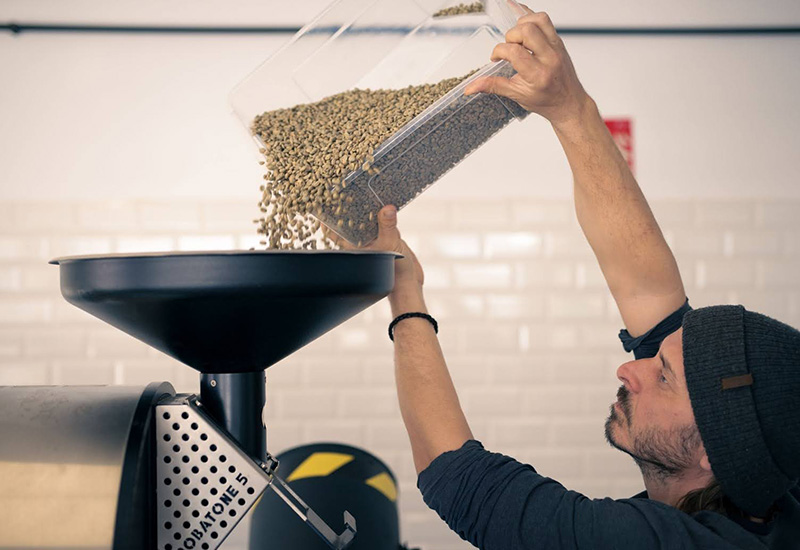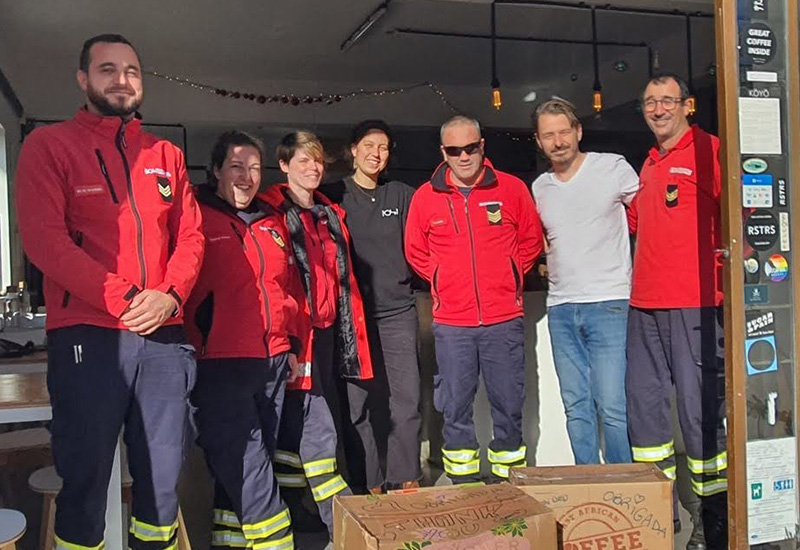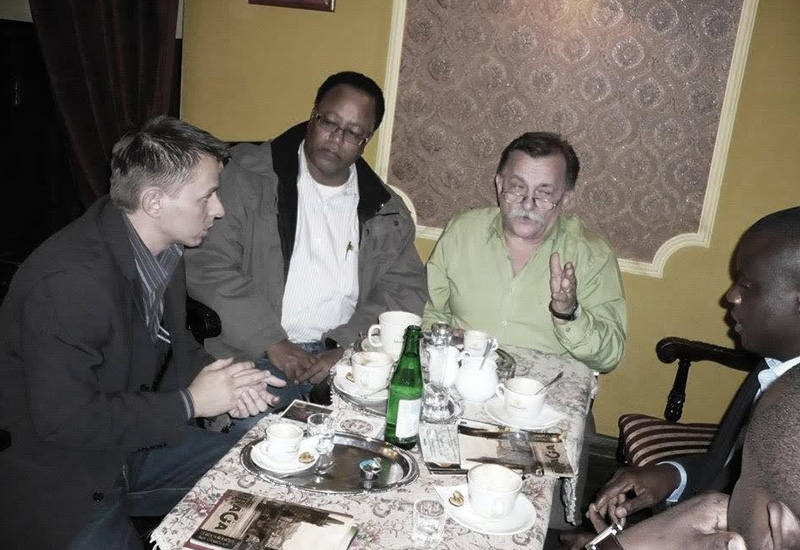Speciality coffee gives us a wake-up call.
Halfway through our two-hour conversation, Gyula Illés, the owner of Kōyō, a speciality coffee roaster based in Aljezur, tells me that Kenyan coffee is one of his favourites. Of course, I proudly then share my own coffee story because I was brought up there.
At an early age, coffee only meant playtime – I had a friend whose parents owned a coffee farm and on our playdates, we would use the coffee baths, where they normally wash the beans, as big water slides. My uncle was also a coffee farmer and I remember vividly, the intensity of the smell of the coffee beans in large hessian sacks that lay all along the floor in huge warehouses where we also played. Gyula is mesmerised by my story as much as I am by his.
While working as a waiter in Budapest in 2006, a position came up in the restaurant behind the bar. The role was preparing coffee. After attending a barista course, he changed the way coffee was served at this establishment, despite the owners’ resistance, and his curiosity about coffee began. He reminisces that serving coffee all day to students could get tedious and that latte art gave him some creative expression to keep it interesting. David Schomer, from Seattle, is credited with the popularisation of latte art in the late 80s, but latte art has been known to exist since the 60s. Latte art is the pattern that is created with the milk that is served on top of the coffee.


In 2008, Gyula entered the latte art competition in Copenhagen, which is organised by the Speciality Coffee Association (SCA), a not-for-profit organisation which was created to serve the coffee trade industry. “The SCA organises national coffee competitions in each country and has a national co-ordinator in each country as well,” he tells me. “It also holds world competitions. In Portugal, the competition level is still very basic, while in other countries, you can compete in latte art, roasting competitions and cup tasting competitions.”
Becoming a barista entails more than just an understanding of latte art. Like the wine grapes, each bean and the region it comes from dictates its flavour and intensity. Factors such as the composition of the soil, the quality of the water and the altitude where it is grown all influence the taste. Eventually, how it is served to the end user is really an art form that professional baristas are fine-tuning every day. A coffee barista learns to taste and serve coffee, similar to how a sommelier tastes and serves wine. Speciality roasters like Kōyō, where trained baristas work, are emerging all over Portugal, and the Algarve already has five in the region.
At Kōyō, the head barista is Dalma Süvegh, who, like the owner, is from Hungary. She shows me the specialist machines behind the counter. Here the ground bean is meticulously measured, weighed and checked against the espresso extraction calculator, which she accesses online. She then inputs the measurements that are provided by the grinding machine. With this calculation, baristas get feedback on the quality of the coffee that they grind, after which they can decide whether it needs tweaking for the taste before they serve it to their customers.


The coffee quality can sometimes register as not optimal on the site, but after Dalma uses her trained and discerning palate, she doesn’t necessarily have to change the ratio. She is the one who ultimately decides if the taste is good enough to serve. A well-honed and trained palate is required to grind fresh barista-grade coffee.
Gyula explains, “What is nice about speciality coffee is that it is a seed from a berry and if you roast it, you can produce different flavours.” His first real flavour sensation from speciality coffee came when he collaborated with Printa, a design shop in Budapest that offered speciality coffee from England. He remembers sipping the coffee and “tasting hints of tomato and other crazy favours”.
Speciality coffee can offer flavours like elderflower, lychee and clove, blood orange, lemongrass, and jasmine, as well as a host of other weird and wonderful combinations which only trained baristas can serve up to perfection.
Kōyō was never meant to be a cafe. It began as a place to roast coffee beans. Its evolution began after a man stood outside the door with his own oat milk, insisting and encouraging Gyula to serve him an artisanal coffee; the huge roasting machine set in the background of the shop along with a delicious smell, obviously gave away that Gyula was likely a professional barista. From this point, more people started arriving and a cafe scene started to form.
Gyula’s intention was only ever to offer workshops, and to showcase and sell sustainably sourced and seasonal speciality coffee. Yet, much to his surprise, Kōyō is now a regular hangout for local expats, some of whom will sometimes spend their whole day here. . . He proudly tells me the cafe “even has a dedicated WhatsApp group run by the regulars to arrange get togethers at Kōyō”.
Gyula’s story is interesting enough to fill a book, but with a limited word count, I believe one particular anecdote highlights what he managed to achieve in the coffee world in Hungary within a short space of time.
He explains that around 2008, an ecovillage in Budapest was set up by Géva Varga, a Hungarian minister interested in sourcing food and seeds to grow. He had the idea to source the green coffee bean from Africa. The minister invited the coffee co-operative presidents from Kenya, Uganda and Tanzania to propose a way for them to export their beans into Eastern Europe.

Gyula’s love of coffee and his pursuit to be the best barista and trainer in Hungary earned him enough recognition to be invited to write a business plan for this project to present to the African Coffee Union. Gyula was so respected for his coffee knowledge and accreditation by then that he found himself in parliament presenting this plan, as well as sitting in meetings with the African co-operative presidents. One of them was Tadesse Maskela, the man behind the documentary film Black Gold, released in 2006.
Black Gold focuses on the Oromia region of southern and western Ethiopia, the birthplace of coffee. Tadesse is the general manager of the Oromia Coffee Farmers Cooperative Union. In the film, he brings to light the exploitation of coffee farmers by the west and his journey to the US and UK to raise awareness of this in the hope of encouraging organisations to cut out the middleman. This change would ensure that coffee farmers with small holdings can be offered a fair price for their crop. The film inspired Gyula and is one of the main reasons he tries to work directly with coffee farmers. “The basic idea of speciality coffee is to be able to pay more directly to farmers,” he says.
With this pioneering idea of importing African green beans, the new co-operative wanted to avoid exchanging money, and instead, everyone in the system, including the small African farmers, could become part owners of this new business. However, for it to get off the ground, Hungary needed to buy 40 tonnes of coffee, the equivalent of one container from each of these three countries. I asked him if it worked and he smiled humbly and told me no, but at least they tried. He admits “the logistics and money needed to get this off the ground just wasn’t in place”.
Gyula was the first ever Hungarian barista certifier, which he achieved by 2009 through the SCA. This put him in a position to work with one of the leading Italian coffee franchisers, Caffè Pertè, where he was offered a trainer position seeing him travelling all around the country teaching staff how to serve coffee. He also trained over 200 Shell petrol station staff in Romania and Slovenia. As a trainer, he was involved with the Wine Academy, Chefparade cooking school and other hospitality industry vocational schools, along with well-known franchises like Semiramis and Sara Lee.

After completing his vigorous technical and sensory judge training with the SCA in Hungary, in 2013 Gyula was invited to be the head judge for the Shell Hungary Amateur Barista Championship. Prior to that, he was a technical judge in a 2011 competition called Coffee in Good Spirit. In 2012, he was a technical jury member for the National Barista Championships. Clearly, the caffeine in the coffee gave him the energy to achieve so much in the coffee world within such a short space of time!
The reality of where your money goes after you pay for your espresso shot is a bigger wake-up call than the caffeine hit that gets you going in the morning. Visiting a speciality coffee house like Kōyō means you are contributing directly towards the income of small coffee farmers, giving them better prospects and livelihoods. So the next time you crave your caffeine fix, consider where you source it carefully..
Kōyō hosts regular workshops. Follow them via social media for regular updates. You can purchase their speciality coffee online or in the cafe.
@koyo_speciality_coffees
Main photo: Koyo Gyula and Dalma – Owner and Head Barista © @Gitam













